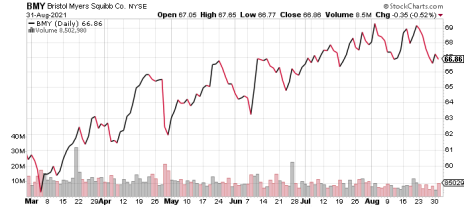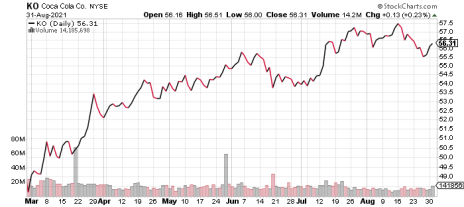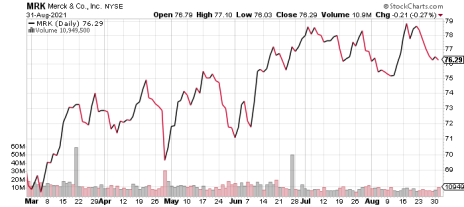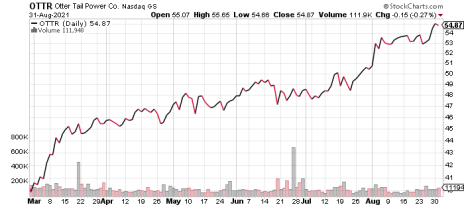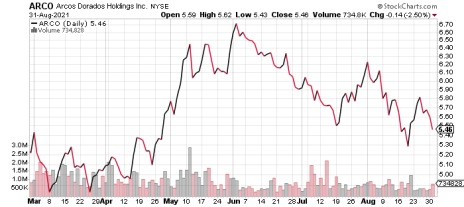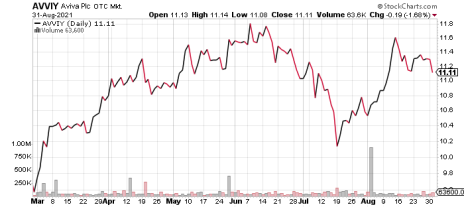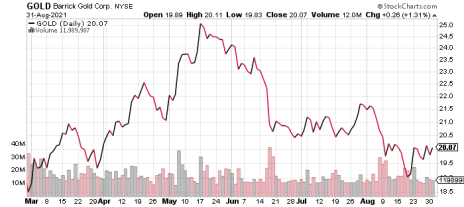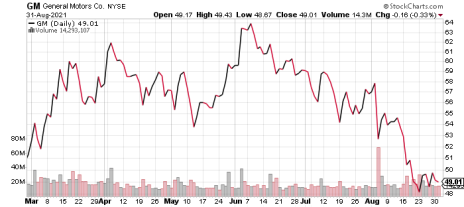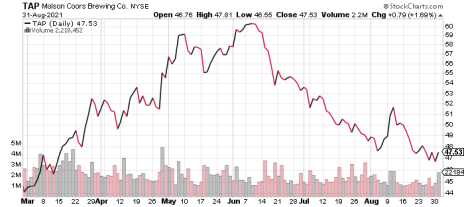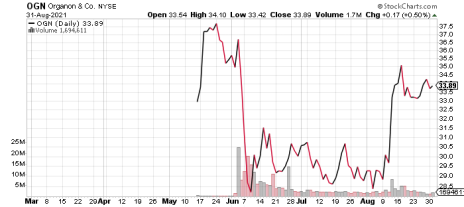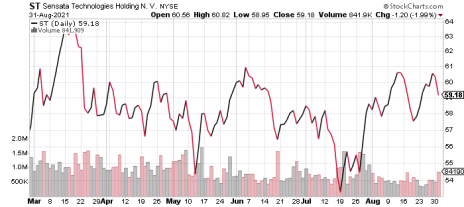Thank you for subscribing to the Cabot Undervalued Stocks Advisor. We hope you enjoy reading the September 2021 issue.
This past week was vacation week – a valuable respite from the stresses of investing and other features of daily life. We now return to the investing desk, ready for what could be a very interesting remaining four months of the stock market year.
There hasn’t been much recent news on our names, so we provide a bit more color on some of the issues surrounding Arcos Dorados (ARCO) and some other names. We would like to see a market pullback to bring shares of otherwise attractive companies back to attractive valuations. However, even in the current market, we are starting to find appealing stocks again and will bring them to you.
Please feel free to send me your questions and comments. This newsletter is written for you and the best way to get more out of the letter is to let me know what you are looking for.
I’m best reachable at Bruce@CabotWealth.com. I’ll do my best to respond as quickly as possible.
Thanks!
Cabot Undervalued Stocks Advisor 921
[premium_html_toc post_id="236614"]
Vacations … A Different Kind of Hard Work
This past week I took my family on our annual vacation in New Hampshire. We stayed at a not-so-modern house built about 90 years ago, with only limited internet access and no TVs (no one listens to the radio anymore). With plenty of lake activities, including small-boat sailing, snorkeling, swimming and just plain ol’ water fun, as well as board games and some poker lessons for the kids in the evening, it was a healthy respite from the stock market, Covid, Afghanistan, politics and all sorts of the other stresses of daily life.
An added benefit – maintaining even a rustic property requires a lot of physical work: roofs need to be cleared of pine needles, dying trees and underbrush need to be cut and removed, water equipment needs to be repaired and cleaned.
Why do I see physical labor as a positive? Mostly because I find it difficult to even think about abstract concepts – how best to value public companies in a raging bull market, what effect the Fed’s policy adjustments might have on our companies’ revenues, and myriad other topics that normally occupy the mind – when hauling away piles of dead wood or wielding sharp tools in the baking hot sun. The mind shuts down its higher thinking to focus on the somewhat mindless yet clearly physical task at hand. And, when the day ends, the body is tired but the brain is rested – the opposite of a typical day at the investing desk.
Rested and recharged. And, ready for what we anticipate will be a very interesting remaining four months of the year for the stock market.
We hope you had a chance to rest and recharge this summer, as well.
Share prices in the table reflect Tuesday (August 31) closing prices. Please note that prices in the discussion below are based on mid-day August 31 prices.
Note to new subscribers: You can find additional color on past earnings reports and other news on recommended companies in prior editions and weekly updates of the Cabot Undervalued Stocks Advisor on the Cabot website.
Send questions and comments to Bruce@CabotWealth.com.
Today’s Portfolio Changes
None
Portfolio changes during the past month
Bristol-Myers Squibb (BMY) – Moving the shares from Strong Buy to Buy.
Cisco (CSCO) – Raising our price target from 55 to 60.
Growth & Income Portfolio
Growth & Income Portfolio stocks are generally higher-quality, larger-cap companies that have fallen out of favor. They usually have some combination of attractive earnings growth and an above-average dividend yield. Risk levels tend to be relatively moderate, with reasonable debt levels and modest share valuations.
| Stock (Symbol) | Date Added | Price Added | 8/31/21 | Capital Gain/Loss | Current Dividend Yield | Price Target | Rating |
| Bristol-Myers Squibb (BMY) | 04-01-20 | 54.82 | 66.86 | 22.0% | 2.9% | 78.00 | Buy |
| Cisco Systems (CSCO) | 11-18-20 | 41.32 | 59.02 | 42.8% | 2.4% | 60.00 | Buy |
| Coca-Cola (KO) | 11-11-20 | 53.58 | 56.31 | 5.1% | 2.9% | 64.00 | Buy |
| Dow Inc (DOW) * | 04-01-19 | 53.50 | 62.90 | 17.6% | 4.5% | 78.00 | Hold |
| Merck (MRK) | 12-9-20 | 83.47 | 76.29 | -8.6% | 3.4% | 99.00 | Buy |
| Otter Tail Corporaton (OTTR) | 5-25-21 | 47.10 | 54.87 | 16.5% | 2.8% | 57.00 | Buy |
Note: DOW price is based on April 1, 2019 closing price following spin-off from DWDP.
Bristol Myers Squibb Company (BMY) shares sell at a low valuation due to worries over patent expirations for Revlimid (starting in 2022) and Opdivo and Eliquis (starting in 2026). However, the company is working to replace the eventual revenue losses by developing its robust product pipeline while also acquiring new treatments (notably with its acquisitions of Celgene and MyoKardia), and by signing agreements with generics competitors to forestall their competitive entry. The likely worst-case scenario is flat revenues over the next 3-5 years. Bristol should continue to generate vast free cash flow, helped by a $2.5 billion cost-cutting program, and has a relatively modest debt level.
On July 28, Bristol reported encouraging second-quarter results with revenues growing 13% from the pandemic-weakened quarter a year ago. Revenues were 4% above the consensus estimate. One of the major debates on Bristol is its ability to grow revenues, so the “beat” is an indicator that we are on the right track.
Adjusted earnings per share of $1.93 rose 18% from a year ago and were slightly higher than the $1.90 consensus estimate. The company reiterated its full-year 2021 revenue and earnings guidance. Net debt was trimmed about 7% from the year end – an important metric that we are watching.
A federal appeals court ruled in favor of competitor Gilead Sciences by overturning a $1.2 billion fine on Gilead. The legal dispute, brought by Bristol subsidiary Juno Therapeutics, alleged that Gilead had infringed on a Juno patent related to the Yescarta treatment. The win was more of a positive for Gilead than a negative for Bristol. The ruling won’t likely impact the market competition for the treatment, although it eliminates any future royalty revenues that Bristol may otherwise have received from Gilead for the treatment.
BMY shares fell 2% in the past week and have about 16% upside to our 78 price target. The shares have pulled back modestly from their 2020 pre-pandemic high and trade just below their 2018 high. We remain patient with BMY shares and continue to have strong conviction in the company’s underlying fundamentals, but due to the share price increase we recently reduced the rating from Strong Buy to Buy.
The stock trades at a low 9.0x estimated 2021 earnings of $7.49 (unchanged from last week). On 2022 estimated earnings of $8.07 (unchanged), the shares trade at 8.3x. Either we are completely wrong about the company’s fundamental strength, or the market must eventually recognize Bristol’s earnings stability and power. We believe the earning power, low valuation and 2.9% dividend yield that is well-covered by enormous free cash flow make a compelling story. BUY
Cisco Systems (CSCO) is facing revenue pressure as customers migrate to the cloud and thus need less of Cisco’s equipment and one-stop-shop services. Cisco’s prospects are starting to improve under a relatively new CEO, who is shifting Cisco toward a software and subscription model and is rolling out new products, helped by its strong reputation and entrenched position within its customers’ infrastructure. The company is highly profitable, generates vast cash flow (which it returns to shareholders through dividends and buybacks) and has a very strong balance sheet.
On August 18, Cisco reported encouraging fiscal fourth-quarter results, particularly with a strong new order flow, and provided favorable and longer-term guidance. The company’s fundamentals are improving, and management is helping boost investor confidence by providing more visibility.
In the quarter, earnings of $0.84/share rose 5% from a year ago, and were 1 cent above the consensus estimate of $0.83. Revenues rose 8% compared to a year ago and were in line with the consensus estimate.
Product revenues rose 8% and product orders grew 31% – encouraging as equipment revenues, particularly Infrastructure Platforms (grew 13%), have been a laggard segment. Enterprise orders, which have been a concern due to their flat/sluggish growth that suggested declining relevancy, rose an impressive 25%. Some of the year/year strength was due to pandemic-weakened orders a year ago, but clearly not all. Strong product sales and orders implies growing relevancy and competitiveness, as well as what appears to be a recovery in underlying demand. In many ways, Cisco shares are driven by revenues, with little need for expanding margins although this would help the shares’ valuation multiple.
In the quarter, operating margin progress was mixed as component shortages and cost pressures weigh on results.
Cash flow from operations was strong at $4.5 billion, up 18% from a year ago. Cisco’s ability to generate cash is a key aspect of the story – this quarter’s robust results provide further support to Cisco’s underlying value. The company returned $2.4 billion of this quarter’s cash flow to investors through dividends and repurchases.
One negative practice we are wary of, however, is that Cisco uses much of its cash flow to make acquisitions. This is in effect a replacement for R&D spending, but as acquisition spending doesn’t hit the income statement like R&D spending does, this practice artificially boosts Cisco’s profitability. For the full fiscal year, the company generated $15.5 billion in operating cash flow, but spent almost half of it on acquisitions. Had this $7 billion been R&D spending, it would have reduced net income by 66%. For reference, its actual R&D spending was about $6.5 billion. Capital spending was only $700 million.
Also, acquisitions usually bring revenues, providing a boost to revenue growth that has almost nothing to do with the company’s core products. Anyone can acquire revenues and this may be hiding dull trends in Cisco’s core revenues. This gaming will likely push us to sell the stock sooner than if its earnings were of higher quality.
Cisco gave FY2022 guidance for revenues to increase between 5%-7% and earnings to grow by about 6%. Both were modestly higher than consensus estimates. The earnings guidance range is remarkably narrow at +/- 1% around the midpoint. We understand they have a strong $31 billion backlog and $22 billion in deferred revenue, both of which provide considerable revenue and profit visibility. But, we are fairly confident that the company’s earnings guidance is very conservative – that is the only way it can provide such a narrow range without risking a “miss” in some future quarter.
This is the first time in years that the company has given year-ahead guidance. The management seems to be showing more confidence in their outlook, both from underlying demand and from their years-long efforts to improve their competitiveness. Helping to highlight this confidence, which of course is contagious on Wall Street, will be their upcoming Investor Day on September 15.
All-in, an encouraging quarter.
There was no significant company-specific news in the past week.
CSCO shares slipped 1% in the past week and have about 2% upside to our recently increased 60 price target.
The shares trade at 17.1x estimated FY2022 earnings of $3.43 (up two cents in the past week). On FY2023 earnings (which ends in July 2023) of $3.67, the shares trade at 16.0x. On an EV/EBITDA basis on FY2022 estimates, the shares trade at a 12.2x multiple. CSCO shares offer a 2.5% dividend yield. We continue to like Cisco. BUY
Coca-Cola (KO) is best-known for its iconic soft drinks yet nearly 40% of its revenues come from non-soda beverages across the non-alcoholic spectrum. Its global distribution system reaches nearly every human on the planet. Coca-Cola’s longer-term picture looks bright but the shares remain undervalued due to concerns over the pandemic, the secular trend away from sugary sodas, and a tax dispute which could cost as much as $12 billion (likely worst-case scenario). The relatively new CEO James Quincey (2017) is reinvigorating the company by narrowing its over-sized brand portfolio, boosting its innovation and improving its efficiency, as well as improving its health and environmental image. Coca-Cola’s balance sheet is sturdy, and its growth investing, debt service and dividend are well-covered by free cash flow.
On July 21, Coca-Cola reported encouraging second-quarter results, with adjusted earnings of $0.68/share, beating the consensus earnings estimate of $0.56 and much stronger than the $0.42 earned a year ago during the depths of the pandemic. Compared to two years ago, unit case volumes matched the two-year-ago level, not bad considering that parts of the global economy remained subdued. The company raised its full-year guidance for organic revenue growth, adjusted EPS and free cash flow. All-in, a good quarter.
Herbert Allen, 80, announced his retirement from Coke’s board of directors after 39 years. Allen is head of Allen & Co, the highly respected and very publicity-shy (no website) investment banking firm based in New York City that focuses on the media, entertainment and technology industries. We believe the retirement is entirely due to Allen’s advancing age. Coca-Cola loses a source of deep institutional knowledge and perspective. There are no plans as yet to replace Allen on the board.
KO shares were flat in the past week and have about 14% upside to our 64 price target.
While the valuation is not statistically cheap, at 25.0x estimated 2021 earnings of $2.25 (flat in the past week) and 23.1x estimated 2022 earnings of $2.43 (flat), the shares remain undervalued given the company’s future earning power and valuable franchise. Also, the value of Coke’s partial ownership of a number of publicly traded companies (including Monster Beverage) is somewhat hidden on the balance sheet, yet is worth about $23 billion, or 9% of Coke’s market value. This $5/share value provides additional cushion supporting our 64 price target. KO shares offer an attractive 3.0% dividend yield. BUY
Dow Inc. (DOW) merged with DuPont to create DowDuPont, then split into three companies in 2019 based on product type. The new Dow is the world’s largest producer of ethylene/polyethylene, the most widely used plastics. Investors undervalue Dow’s hefty cash flows and sturdy balance sheet largely due to its uninspiring secular growth traits and its cyclicality. The shares are driven by: 1) commodity plastics prices, which are often correlated with oil prices and global growth, along with competitors’ production volumes; 2) volume sold, largely driven by global economic conditions, and 3) ongoing efficiency improvements (a never-ending quest of all commodity companies). Investors worry about a cyclical peak and whether Dow will squander its vast free cash flow. We see Dow as having more years of strong profits before capacity increases signal a cyclical peak, and expect the company to continue its strong dividend, reduce its pension and debt obligations, repurchase shares slowly and restrain its capital spending.
On July 22, Dow reported a strong second quarter, with adjusted earnings of $2.72/share, about 16% above the consensus estimate of $2.35 and sharply higher than the $(0.26) loss a year ago in the depths of the pandemic. Management has an encouraging outlook for volumes and pricing and for its ability to generate higher profits on comparable revenues. While profits may be peaking in coming quarters, they will likely remain elevated rather than fall off sharply. Industry capacity increases are coming next year, but we do not see large price cuts from our current vantage point. We would like to see Dow generate more free cash flow, trim its debt and issue fewer stock options.
Dow will host an investor day on October 6, starting at 10am, which will be accessible via the Dow website.
There was no significant company-specific news in the past week.
Dow shares were flat this past week and have 24% upside to our 78 price target. On estimated 2022 earnings of $5.89 (unchanged in the past week), the shares trade at a 10.7x multiple.
Analysts are somewhat pessimistic about 2022 earnings (they assume a 31% decline from 2021). If the 2022 estimate continues to tick up, the shares will likely follow, although Dow’s cyclical earnings and investor fears of an eventual downcycle will ultimately limit Dow’s upside. The high 4.4% dividend yield adds to the shares’ appeal. In a prolonged downcycle, the dividend could be cut, but that could be years away and even then a cut isn’t a certainty if Dow can manage its balance sheet and down-cycle profits reasonably well. HOLD
Merck (MRK) shares are undervalued as investors worry about Keytruda, a blockbuster oncology treatment (about 30% of revenues), facing generic competition in late 2028. Also, its Januvia diabetes treatment may see generic competition next year, and like all pharmaceuticals it is at-risk from possible government price controls. Yet, Keytruda is an impressive franchise that is growing at a 20% rate and will produce solid cash flow for nearly seven more years, providing the company with considerable time to replace the potential revenue loss. Merck’s new CEO, previously the CFO, will likely accelerate Merck’s acquisition program, which adds both return potential and risks to the story. The company is highly profitable and has a solid balance sheet. It spun off its Organon business in June and we think it will divest its animal health sometime in the next five years.
On July 29, Merck’s reported satisfactory second-quarter results. Revenues grew 19% from a pandemic-weakened year-ago quarter (excluding favorable currencies) and were slightly ahead of consensus estimates. Keytruda sales were strong. Adjusted earnings increased 28% from a year ago but fell slightly short of the $1.33 consensus estimate. Higher costs led to the earnings “miss” but this seems more like analysts being too optimistic rather than any fundamental issues weighing on the company. Merck’s balance sheet and cash flow looked solid. The company raised its full-year revenue guidance, reiterated its confidence in its new product pipeline and is planning on small-to-large acquisitions.
There was no significant company-specific news in the past week.
Merck shares slipped 2% this past week and have about 30% upside to our 99 price target. Valuation is an attractive 13.8x this year’s estimated earnings of $5.55 (down a cent in the past week). Merck produces generous free cash flow to fund its current dividend (now yielding 3.4%) as well as likely future dividend increases, although its shift to a more acquisition-driven strategy will slow the pace of increases. BUY
Otter Tail Corporation (OTTR) is a rare utility/industrial hybrid company, with a $2 billion market cap. The electric utility has a solid and high-quality franchise, with a balanced mix of generation, transmission and distribution assets that produce about 75% of the parent company’s earnings, supported by an accommodative regulatory environment. The industrial side includes the Manufacturing and Plastics segments. Otter Tail has an investment grade balance sheet, produces solid earnings and prides itself on steady dividend growth. The unusual utility/manufacturing structure is creating a discounted valuation, which might make the company a target for activists, as the two parts may be worth more separately, perhaps in the hands of larger, specialized companies.
On August 2, Otter Tail reported strong second-quarter results, with earnings rising 141% from a year ago and were nearly double the consensus estimate. Full-year guidance was raised by about 40%. The profit surge was driven by the Plastics segment, as PVC resin supplies were exceptionally tight, largely due to the Texas winter storms, creating a PVC pipe shortage that allowed Otter Tail to sharply raise its PVC pipe prices. The company anticipated that these unusual conditions would last through 2021 but moderate into 2022. Electric segment profits rose a steady 5%. The company is progressing through its Minnesota rate case – we anticipate a benign outcome. Otter Tail’s balance sheet remains in good shape, although the steady expansion of its electric utility rate base continues to siphon off considerable cash flow.
There was no significant company-specific news in the past week.
OTTR shares rose 5% this past week and have about 3% upside to our 57 price target. The stock trades at about 15.4x estimated 2021 earnings of $3.59 (up 10% as analysts bring their estimates in-line with the company’s guidance for about $3.58). The shares offer a 2.8% dividend yield. BUY
Buy Low Opportunities Portfolio
Buy Low Opportunities Portfolio stocks include a wide range of value opportunities, often with considerable upside. This group may include stocks across the quality and market cap spectrum, including those with relatively high levels of debt and a less-clear earnings outlook. The stocks may not pay a dividend. In all cases, the shares will trade at meaningful discounts to our estimate of fair value.
| Stock (Symbol) | Date Added | Price Added | 8/31/21 | Capital Gain/Loss | Current Dividend Yield | Price Target | Rating |
| Arcos Dorados (ARCO) | 04-28-21 | 5.41 | 5.46 | 0.9% | — | 7.50 | Buy |
| Aviva (AVVIY) | 03-03-21 | 10.75 | 11.11 | 3.3% | 5.3% | 14.00 | Buy |
| Barrick Gold (GOLD) | 03-17-21 | 21.13 | 20.07 | -5.0% | 1.8% | 27.00 | Buy |
| General Motors (GM) | 12-31-19 | 36.60 | 49.01 | 33.9% | — | 69.00 | Hold |
| Molson Coors (TAP) | 08-05-20 | 36.53 | 47.53 | 30.1% | — | 69.00 | Buy |
| Organon (OGN) | 06-07-21 | 31.42 | 33.89 | 7.9% | — | 46.00 | Buy |
| Sensata Technologies (ST) | 02-17-21 | 58.57 | 59.18 | 1.0% | — | 75.00 | Buy |
Arcos Dorados (ARCO), which is Spanish for “golden arches,” is the world’s largest independent McDonald’s franchisee. Based in stable Uruguay and listed on the NYSE, the company produces about 72% of its revenues in Brazil, Mexico, Argentina and Chile. Arcos’ leadership looks highly capable, led by the founder/chairman who owns a 38% stake. The shares are undervalued as investors worry about the pandemic, as well as political/social unrest, inflation and currency devaluations. However, the company is well-managed and positioned to benefit as local economies reopen, and it has the experience to successfully navigate the complex local conditions. Debt is reasonable relative to post-recovery earnings, and the company is currently producing positive free cash flow.
On August 11, Arcos reported encouraging second-quarter results. Revenues rebounded sharply, with systemwide same-store sales nearly equal to the two-year-ago period, despite many of its restaurants still under government capacity and operating hours restrictions. About 75% of all of its restaurants are in full-operations with others partly opened. Adjusted EBITDA was strong but still shy of where a fully recovered Arcos would produce. Net financial debt increased as the company produced negative free cash flow. Once at full-strength, we would expect cash flow to be robust.
The Brazilian currency (the real) appears to have stabilized around $0.19, after falling sharply during the pandemic from around $0.26. In a normal year, Arcos generates as much as 75% of its profits from Brazil, so the currency has an outsized impact on company results, which are reported in US dollars. While Brazil’s currency has been on a volatile but clear trend of depreciation over the past 25 years (it traded at parity with the dollar in the late 1990s), we are hopeful for a period of post-pandemic currency stability.
A slow vaccination pace, combined with Brazil’s limited ability to use fiscal and monetary stimulus, has delayed the country’s economic recovery relative to the US and other developed nations. However, the pace of vaccinations in Brazil appears to be accelerating, which should boost economic results later this year, likely boosting Arcos’ business.
The political situation is edgier, as slow job growth increases the pressure on the president, Jair Bolsonaro. There is a chance that ongoing weak labor market conditions could result in a return to the presidency of Lula da Silva, a former president, following the 2022 elections. Major polls point in this direction. Political and economic forecasting is not the forte of the Cabot Undervalued Stock Advisory. Our initial thoughts might be that a da Silva win could boost wages and jobs in the near term (a positive for McDonalds’ revenues) but eventually would produce weaker growth and a weaker currency.
These are probably some of the larger issues that overhang Arcos’ shares.
ARCO shares slipped 5% this past week and have about 37% upside to our 7.50 price target.
We remain steady in our conviction in the company’s recovery. The low share price offers a chance to add to or start new positions. The stock trades at 18.9x estimated 2022 earnings per share of $0.29 (unchanged from a week ago). The 2021 estimate remained at $0.03. The 2023 consensus estimate of $0.36 rose a cent. BUY
Aviva, plc (AVVIY), based in London, is a major European insurance company specializing in life insurance, savings and investment management products. Amanda Blanc was hired as the new CEO last year to revitalize Aviva’s laggard prospects. She has divested operations around the world to aggressively re-focus the company on its core geographic markets (UK, Ireland, Canada), and is improving Aviva’s product competitiveness, rebuilding its financial strength and trimming its bloated costs. Aviva’s dividend has been reduced to a more predictable and sustainable level with a modest upward trajectory. Excess cash balances are being directed toward debt reduction and potentially sizeable special dividends.
On Thursday, August 12, Aviva reported reasonable first-half 2021 results. Operating profits rose 17% from a year ago (but missed the consensus estimate), with the increase due to the operating improvements and divestitures over the past year. A major reason for the “miss” was a discretionary charge to boost its legacy life insurance reserves – real money but more reflective of prior errors than going-forward results. The company is making important and meaningful changes to its core business.
Much of our interest in Aviva is in what it plans to do with its current and future excess capital, including the proceeds from its divestitures. So far, the company has recently raised its interim dividend by 5% to £0.0735/share (about $0.20 per ADS, as there are 2 underlying common shares per ADS, and the exchange rate is about $1.38) and will return at least £4 billion (about $5.5 billion) by 2H 2022, mostly through share buybacks. It will complete £750 million starting “immediately.” The balance of the divestiture proceeds will go toward debt paydown.
We anticipate that the company will pay a final (year-end) dividend of about twice its interim dividend, for a full-year total recurring dividend of about $0.61/ADS. On this, the shares would produce an annual dividend yield of about 5.5% – rather appealing in an era when AA-rated corporate bonds yield about 1.7%
Activist investor Cevian (they continue to add to their 5% stake) is not satisfied with the pace of capital returns. The group is pressing for at least £5 billion in capital returns. We are pleased to have Cevian in our corner.
There was no significant company-specific news in the past week.
Aviva shares slipped 3% this past week and have about 26% upside to our 14 price target.
The stock trades at 8.1x estimated 2021 earnings per ADS of $1.38 (up 3 cents in the past week) and at about 97% of tangible book value. BUY
Barrick Gold (GOLD), based in Toronto, is one of the world’s largest and highest-quality gold mining companies. About 50% of its production comes from North America, with the balance from Africa/Middle East (32%) and Latin America/Asia Pacific (18%). The market has little interest in Barrick shares. Yet, Barrick will continue to improve its operating performance (led by its new and highly capable CEO), generate strong free cash flow at current gold prices, and return much of that free cash flow to investors while making minor but sensible acquisitions. Also, Barrick shares offer optionality – if the unusual economic and fiscal conditions drive up the price of gold, Barrick’s shares will rise with it. Given their attractive valuation, the shares don’t need this second (optionality) point to work – it offers extra upside. Barrick’s balance sheet has more cash than debt. Major risks include the possibility of a decline in gold prices, production problems at its mines, a major acquisition and/or an expropriation of one or more of its mines.
On August 9, Barrick reported mixed second-quarter results. Adjusted earnings of $0.29/share rose 26% from a year ago and were about 12% above the consensus estimate. A production issue reduced its Carlin (Nevada) mine output but the company said it remains on track to meet full-year total company production guidance. Barrick continues to invest in new mining projects while maintaining a reasonable capital spending budget. We would have liked to have seen better results on volumes and costs. Barrick is a free cash flow story, so the negative free cash flow this quarter was disappointing, and tipped the balance sheet back into a net debt position (compared to the net cash a quarter ago).
The threat of local governments taking control of gold mines remains. As the free world shrinks, autocratic governments become more assertive about taking assets from Western companies. Most of Barrick’s production comes from countries unlikely to expropriate, but takings at the margin will weigh on the shares.
There was no significant company-specific news in the past week.
Commodity gold prices ticked upward to $1,814/ounce, although the 10-year Treasury yield ticked up to 1.30%. Gold prices seems range-bound.
Barrick shares were flat this past week and have about 35% upside to our 27 price target. The price target is based on 7.5x estimated 2021 EBITDA and a modest premium to our estimate of $25/share of net asset value.
On its recurring $.09/quarter dividend, GOLD shares offer a reasonable 1.8% dividend yield. Barrick will pay an additional $0.42/share in special distributions this year, lifting the effective dividend yield to 3.9%. BUY
General Motors (GM) is making immense progress with its years-long turnaround. It is perhaps 90% of the way through its gas-powered vehicle turnaround, and is well-positioned but in the early stages of its electric vehicle (EV) development. GM Financial will likely continue to be a sizeable profit generator. GM is fully charged for both today’s environment and the EV world of the future, although the underlying value of its emerging EV business is unclear.
On August 4, GM reported strong results that were nevertheless held back by the chip shortage and a large $1.3 billion warranty expense. It appears that the company’s ability to generate ever-higher profits is maxed out. Future profits (adjusted for these one-time costs) will not likely be higher, but we see a tapering decay rate rather than a cliff. However, we also wonder what the eventual profitability of electric vehicles will be and the return on GM’s vast capital outlay. GM Finance and the overall balance sheet both look sturdy.
The shares reflect conservative but reasonably strong gas-powered vehicle profits but assign no value to the EV operations. This zero value almost certainly is wrong but the EV operations have no sales or profits so the valuation is by definition speculative at this point. We’re keeping GM a Hold for now, as the risk/return balance isn’t as favorable as we would like for the Cabot Undervalued Stocks Advisory.
More evidence points to manufacturing defects at LG Chem, the maker of GM’s EV batteries, as the problem behind the recent battery fires. Korean maker Hyundai, which also uses LG Chem batteries, has recently reported battery fires. GM is in a rush to build its own batteries, with what we believe is a goal of dropping LG Chem as a supplier. However, it appears that not all LG Chem batteries are defective, as customers Ford and Volkswagen apparently haven’t had problems.
GM’s Bolt recall price tag is now upwards of $1.8 billion.
The semiconductor shortage shows few signs of relenting, although we continue to expect that it will be resolved by early 2022.
GM shares fell 1% this past week and have 40% upside to our 69 price target.
On a P/E basis, the shares trade at 7.1x estimated calendar 2022 earnings of $6.96 (unchanged this past week). The 2021 estimate slipped 2 cents to $6.39. The P/E multiple is helpful, but not a precise measure of GM’s value, as it has numerous valuable assets that generate no earnings (like its Cruise unit, which is developing self-driving cars and produces a loss), its nascent battery operations, and its other businesses with a complex reporting structure, nor does it factor in GM’s high but unearning cash balance which offsets its interest-bearing debt. However, it is useful as a rule-of-thumb metric, and provides some indication of the direction of earnings estimates, and so we will continue its use here. HOLD
Molson Coors Beverage Company (TAP) is one of the world’s largest beverage companies, producing the highly recognized Coors, Molson, Miller and Blue Moon brands as well as numerous local, craft and specialty beers. About two-thirds of its revenues come from the United States, where it holds a 24% market share. Investors worry about Molson Coors’ lack of revenue growth due to its relatively limited offerings of fast-growing hard seltzers and other trendier beverages. Our thesis for this company is straight-forward – a reasonably stable company whose shares sell at an overly discounted price. Its revenues are resilient, it produces generous cash flow and is reducing its debt. A new CEO is helping improve its operating efficiency and expand carefully into more growthier products. The company recently reinstated its dividend.
The company’s second-quarter report on July 29 was encouraging. Revenues rose 14%, powered by a resurgence in Europe. Revenues were about 4% ahead of the consensus estimate. Adjusted net income rose 2% from a year ago and was 17% above the consensus estimate. However, adjusted EBITDA fell 1%, as the company spent more on marketing and battled rising transportation, brewery and packaging materials costs. Beating the revenue and earnings estimates is important as it supports our view that investors don’t fully appreciate the resiliency in Molson’s business. The company reaffirmed its 2021 full-year guidance. Molson’s debt balance is unchanged from year end but cash is starting to accumulate.
There was no significant company-specific news in the past week.
TAP shares slipped 2% in the past week and have about 45% upside to our 69 price target. The shares trade at 11.9x estimated 2021 earnings of $4.01 (unchanged this past week). Estimates for 2022 were also unchanged.
On an EV/EBITDA basis, or enterprise value/cash operating profits, the shares trade for about 8.2x current year estimates, still among the lowest valuations in the consumer staples group and below other brewing companies. BUY
Organon & Company (OGN) was recently spun off from Merck. It specializes in patented women’s healthcare products and biosimilars, and also has a portfolio of mostly off-patent treatments. Organon will produce better internal growth with some boost through smart yet modest-sized acquisitions. It may eventually divest its Established Brands segment. The management and board appear capable, the company produces robust free cash flow, has modestly elevated debt and will pay a reasonable dividend. Investors have ignored the company, but we believe that Organon will produce at least stable and large free cash flows with a reasonable potential for growth. At our initial recommendation, the stock traded at a highly attractive 4x earnings.
On August 12, Organon reported encouraging results, reaffirmed their full-year guidance and initiated a $0.28/share quarterly dividend.
Revenues rose 5% from a year ago and were about 4% above the consensus estimate. The company reaffirmed their outlook for $6.1 billion -$6.4 billion in full-year revenues. While the headwinds we highlighted in our initiation report remain in place, Organon highlighted on the conference call a wide range of initiatives and end-market trends that provide support for its positive outlook. Adjusted EBITDA of $627 million was about 12% above the consensus estimate.
There was no other significant company-specific news in the past week.
OGN shares rose 2% in the past week and have about 36% upside to our 46 price target (using the same target as the Cabot Turnaround Letter). The shares trade at 5.6x estimated 2021 earnings of $6.02 and 5.7x estimated 2022 earnings of $5.95. Both of these estimates moved higher in the past week. Consistent with our thesis that Organon can generate at least steady revenues and profits, the consensus estimate for 2023 is a more robust $6.18, up by 3 cents in the week. Organon shares offer an attractive 3.3% dividend yield. BUY
Sensata Technologies (ST) is a $3.8 billion (revenues) producer of nearly 47,000 highly engineered sensors used by automotive (60% of revenues), heavy vehicle, industrial and aerospace customers. About two-thirds of its revenues are generated outside of the United States, with China producing about 21%. Investors undervalue Sensata’s durable franchise. Its sensors are typically critical components that generally produce high profit margins. Also, as the sensors’ reliability is vital to safely and performance, customers are reluctant to switch to another supplier that may have lower prices but also lower or unproven quality. Sensata has an arguably under-leveraged balance sheet and generates healthy free cash flow. The relatively new CEO will likely continue to expand the company’s growth potential through acquisitions.
Once a threat, electric vehicles are now an opportunity, as the company’s expanded product offering (largely acquired) allows it to sell more content into an EV than it can into an internal combustion engine vehicle. Risks include a possible automotive cycle slowdown, chip supply issues, geopolitical issues with China, currency and over-paying/weak integration related to its acquisitions.
On July 27, Sensata reported encouraging second-quarter results. Its earnings were sharply higher than the pandemic-weakened results a year ago and about 10% above the consensus estimate. Revenues were 72% higher than a year ago and were also above estimates. The company raised its full-year revenue and earnings guidance. Cash flow was robust and net debt increased modestly to fund the Xirgo acquisition.
There was no significant company-specific news in the past week.
ST shares rose 1% this past week and have about 26% upside to our 75 price target. The stock trades at 14.3x estimated 2022 earnings of $4.17 (unchanged this past week). On an EV/EBITDA basis, ST trades at 12.9x estimated 2022 EBITDA. BUY
Disclosure: The chief analyst of the Cabot Undervalued Stocks Advisor personally holds shares of every recommended security, except for “New Buy” recommendations. The chief analyst may purchase or sell recommended securities but not before the fourth day after any changes in recommendation ratings has been emailed to subscribers. “New Buy” recommendations will be purchased by the chief analyst as soon as practical following the fourth day after the newsletter issue has been emailed to subscribers.
Strong Buy – This stock offers an unusually favorable risk/reward trade-off, often one that has been rated as a Buy yet the market has sold aggressively for temporary reasons. We recommend adding to existing positions.
Buy – This stock is worth buying.
Hold – The shares are worth keeping but the risk/return trade-off is not favorable enough for more buying nor unfavorable enough to warrant selling.
Sell – This stock is approaching or has reached our price target, its value has become permanently impaired or changes in its risk or other traits warrant a sale.
Note for stock table: For stocks rated Sell, the current price is the sell date price.
The next Cabot Undervalued Stocks Advisor issue will be published on October 6, 2021.
Cabot Wealth Network
Publishing independent investment advice since 1970.
President & CEO: Ed Coburn
Chief Investment Strategist: Timothy Lutts
Cabot Heritage Corporation, doing business as Cabot Wealth Network
176 North Street, PO Box 2049, Salem, MA 01970 USA
800-326-8826 | support@cabotwealth.com | CabotWealth.com
Copyright © 2021. All rights reserved. Copying or electronic transmission of this information without permission is a violation of copyright law. For the protection of our subscribers, copyright violations will result in immediate termination of all subscriptions without refund. Disclosures: Cabot Wealth Network exists to serve you, our readers. We derive 100% of our revenue, or close to it, from selling subscriptions to our publications. Neither Cabot Wealth Network nor our employees are compensated in any way by the companies whose stocks we recommend or providers of associated financial services. Employees of Cabot Wealth Network may own some of the stocks recommended by our advisory services. Disclaimer: Sources of information are believed to be reliable but they are not guaranteed to be complete or error-free. Recommendations, opinions or suggestions are given with the understanding that subscribers acting on information assume all risks involved. Buy/Sell Recommendations: are made in regular issues, updates, or alerts by email and on the private subscriber website.
Subscribers agree to adhere to all terms and conditions which can be found on CabotWealth.com and are subject to change. Violations will result in termination of all subscriptions without refund in addition to any civil and criminal penalties available under the law.

